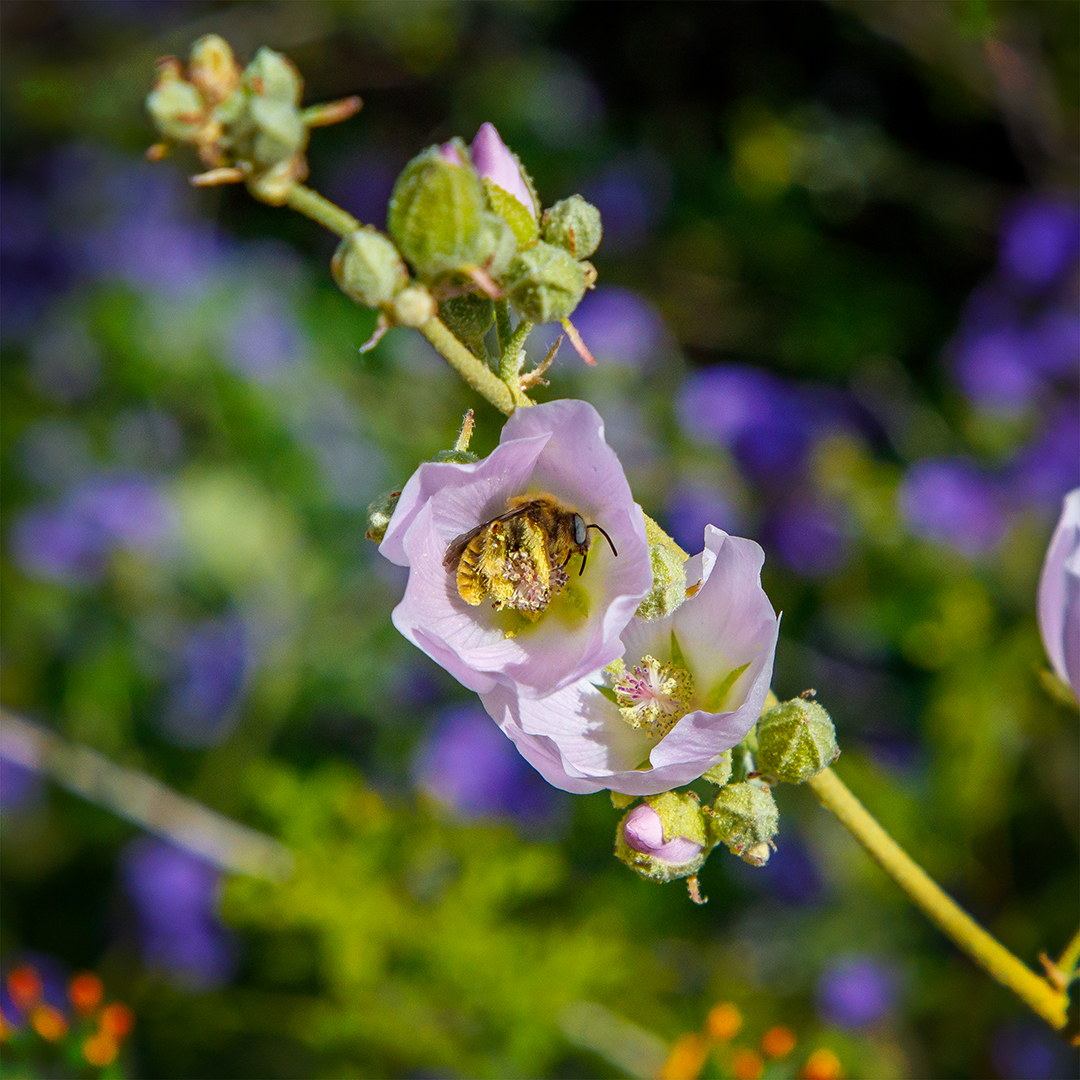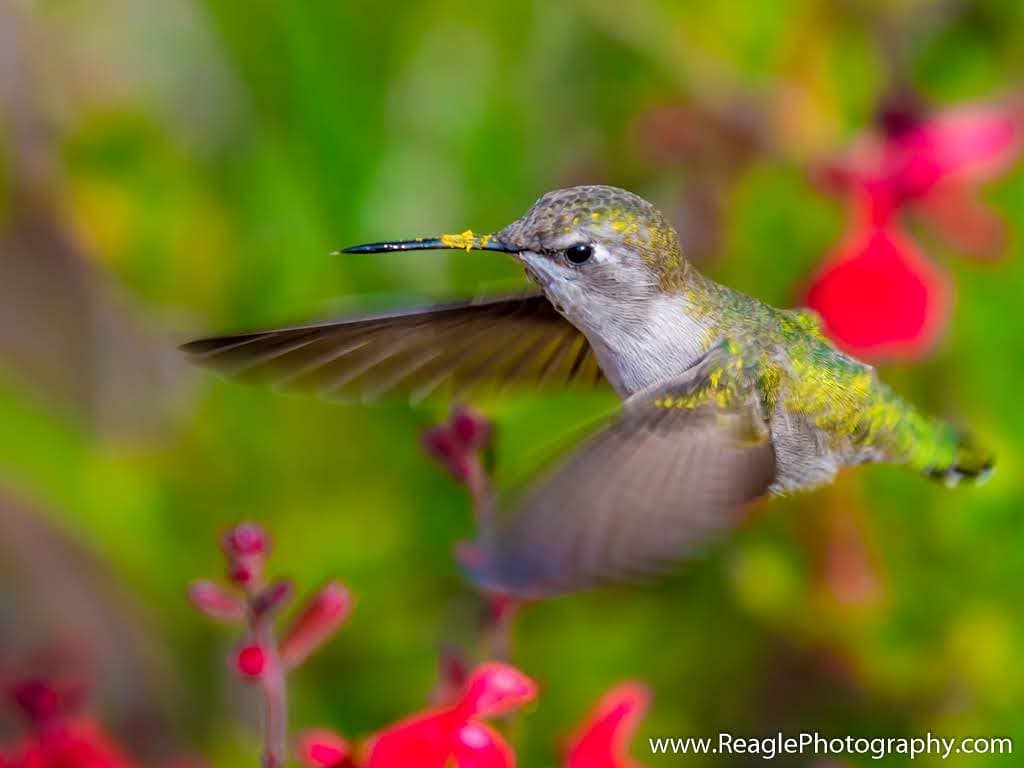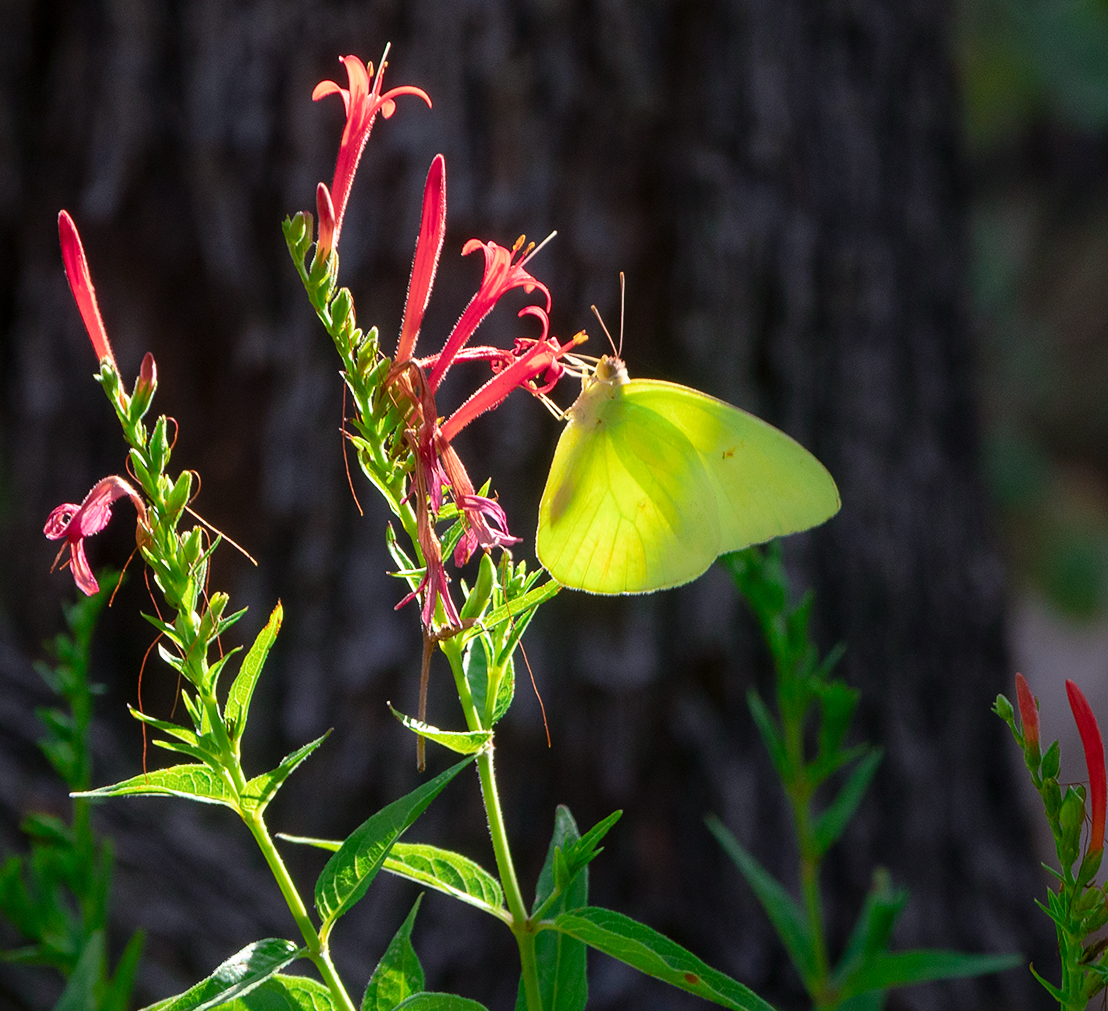
Arizona Pollinators
Let’s talk about the birds and the bees… bats, butterflies, moths, flies, and all the insects and other animals that serve as pollinators! Get to know the pollinators of Arizona. There are so many that you won’t find a list of pollinators here but we’ll highlight some key animals that pollinate. Read on to appreciate them for their incredible importance and to learn simple ways you can support conservation efforts for pollinators.
Why are Pollinators Important?
Do you like food? How about fruits, nuts, chocolate, coffee? Then you like pollinators! Pollinator species such as birds and insects are essential partners of farmers, ranchers, and gardeners in producing most of our food supply. In fact, it’s estimated that 1 in 3 bites of food we owe to animal pollinators!
 Let’s put on our science hats for a moment and get down to the nitty gritty of it. To grow, flowering plants must have the pollen from the stamen (male part of the flower) to the stigma (female part of the flower) to reproduce more plants. Sometimes plants are pollinated by the wind or can even self-pollinate, but many plants rely on animal pollination to reproduce. Insects, birds, bats, and other small animals are essential for pollination and critical to ecological biodiversity.
Let’s put on our science hats for a moment and get down to the nitty gritty of it. To grow, flowering plants must have the pollen from the stamen (male part of the flower) to the stigma (female part of the flower) to reproduce more plants. Sometimes plants are pollinated by the wind or can even self-pollinate, but many plants rely on animal pollination to reproduce. Insects, birds, bats, and other small animals are essential for pollination and critical to ecological biodiversity.
Aside from food production, pollination plays a vital role in the health of our forests and grasslands, which provide forage, fish and wildlife, timber, water, mineral resources, and recreational opportunities as well as enhanced economic development opportunities for communities.
Animals that Pollinate in Arizona
When picturing a pollinator, your mind probably conjures up images of a fuzzy black and yellow insect buzzing around flowers. It’s true, bees are probably the most famous incredibly important pollinators, and for good reason! But they aren't alone in their pollination efforts. Discover how other insects, birds, and even bats contribute to this intricate natural process. From the nighttime activities of moths to the nectar-sipping habits of hummingbirds, each creature adds a unique touch to the pollination puzzle. Keep reading to uncover the fascinating ways these pollinators help keep Arizona's ecosystems thriving!
Insect Pollinators

a globemallow flower.
Bees are known to be hard workers, and are very efficient pollinators! There are more than 1,300 native species of bees in Arizona. Learn about some of the most common varieties from this handy bee identification guide from a University of Arizona Pollinator Partnership. While there's so much to appreciate about these insects, we can't help but marvel at how the pollen grain gets stuck on their hairs, transferring the pollen to other flowers.
Bees also have pollen baskets—little pockets on their legs they use to pack in pollen from flowers and carry back to the nest to feed their young. Nature really works together as a team to sustain the tremendous floral diversity of Arizona!
You know what else pollen sticks to? The legs and wings of moths and butterflies! While they may be less efficient pollinators than bees, flowering plants, and these beautiful winged creatures have a mutually beneficial relationship. Butterflies and moths land on flowers to get energy from their nectar and as a result, transfer pollen.
Arizona has hundreds of species of butterflies and moths. Moths may get a bad rap for the way they defoliate plants in their caterpillar form, but they also do some good in their pollination, particularly with night-blooming species. For more reading about moths, check out this interesting info from the Arizona-Sonora Desert Museum about moths and their relationship with yucca plants.
Lastly, don’t forget about other insects that happen to crawl on flowering plants and coincidentally transfer pollen, like beetles, spiders, crickets, ants, and more. The insect world is made up of a HUGE number of TINY animals. Discover some of our common bugs in Arizona from around our parks.

pollen on its beak and feathers.
Photo by Rodrigo Izquierdo, @reaglephotography
Bird Pollinators
Finish the sentence: Birds eat insects, berries, and _______. Did you say “seeds”? You’re right, they do eat seeds, but many also eat nectar from flowers… something you may not think about when picturing an avian diet! When birds do feed on nectar, they also become carriers for hitchhiking pollen, just like insects.
One of the most famous feathered friends who does this is the hummingbird. Arizona’s diverse hummingbird population consists of at least 17 species, including seasonal visitors passing through the state during migration.
Hummingbirds aren’t the only nectar-sipping avian species that help pollinate, though. Another common bird you’ve likely seen right in your backyard if you live in Arizona is the white-winged dove. They’re a famous pollinator of the saguaro cactus. Many other birds are attracted to delectable nectar, including verdins, orioles, and even woodpeckers.
Mammal Pollinators
.jpg)
pollen-laden flower with many yellow stamens.
Photo by J Scott Altenbach
When it comes to pest control and desert plant pollination, the sky puppies are star performers! Yes, we’re talking about bats, and Arizona has 28 species of them! Bats transfer pollen from one flower to another while they feed on nectar and pollen. As a major added bonus, bats naturally control pests and eat between 50-100% of their body weight in insects each night!
Still need some convincing to be on the bats’ side? Consider this: among many desert plants, the Agave plant, which is used in making tequila, depends on bats for pollination. So thank a bat next time you sip on the limey goodness of a refreshing margarita. There are so many other plants that we owe a debt of gratitude to bats for pollinating. Hear about more of them from Kartchner Caverns Volunteer Randa in a short video.
Want to learn more about bats? Check out a Bat Walk at Kartchner Caverns State Park, where you’ll explore the park at night guided by a ranger and have the opportunity to ask questions and even observe bat social and hunting behavior in the wild!
If you see a bat in distress or lying on the ground, please remember that they should never be picked up bare-handed. Bats may fall to the ground from exhaustion or injury, but if they are unable to move, they may be sick. We recommend contacting the local Arizona Game and Fish Department office or a local bat rescue for guidance.
How You Can Help Pollinators
Threats to pollinators include a shrinking habitat as developed spaces expand, the spread of invasive plants that crowd out native species that pollinators rely on, improper use of pesticides, and the effects of climate change which impacts the germination cycles of plants, devastation of habitat due to wildfires, and rising temperatures. There are simple ways you can help our pollinators. Check out some small actions that can make a big difference, below.

from a Firecracker Penstemon flower.
Plant a Pollinator Garden
Take a moment to appreciate birds, bats, butterflies, and bees for keeping the earth growing and providing! Try planting some native flowers in your garden to give back to the pollinators.
We know planting a pollinator garden in Arizona can sound intimidating given the state’s arid conditions, but planting native is your key to success! Find an ecoregional planting guide for where you live at pollinator.org. When invasive weeds sprout in your garden, pull them quickly to reduce their spread. You can even volunteer to help remove invasive plants in parks and public lands.
Don’t forget to include water and shelter to complete your pollinator-friendly habitat. Bird houses are a familiar one, but bat houses are a great solution, too! Don’t forget to leave areas in your garden where leaves or a few small sticks or branches can stay on the ground and compost (away from structures, for fire safety purposes). This organic material will enrich the soil and nutritional value it offers pollinators, and provide places for pollinating insects to live and grow through their life cycles. Lastly, avoid the use of pesticides and herbicides which can weaken pollinators.
Embrace the Dark Sky
Reduce light pollution so nocturnal pollinators like bats and moths can do their best work. Artificial light at night can reduce the number of pollinators that visit the lit area, can confuse and disorient pollinators, and even disrupt their circadian rhythm used to sense time. By reducing your light pollution, you’ll also be helping migratory birds that navigate through stretches of their long journeys at night.
.png) Take these simple actions to ensure you’re lighting the outdoors responsibly and protecting pollinators:
Take these simple actions to ensure you’re lighting the outdoors responsibly and protecting pollinators:
- adjust the sensitivity settings on your motion-activated lights
- limit when the light is on with a timer
- shield and aim lights downwards toward the ground
- remove lights that don’t have a clear purpose
- keep the light low-level and warm-colored
Raise awareness for Pollinator Conservation
Participate in conservation efforts by simply spreading the word about the importance of pollinators and how we can help them! June is National Pollinator Month, and National Pollinator Week runs from June 16 to 22, 2025. These are excellent opportunities to share your knowledge about pollinators. Take to your own social media, participate in a local event, or if you have kids or are an educator, teach children about how special and valued pollinators truly are.

